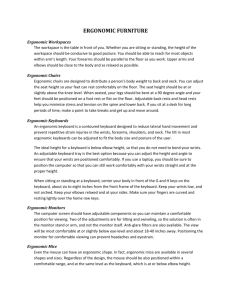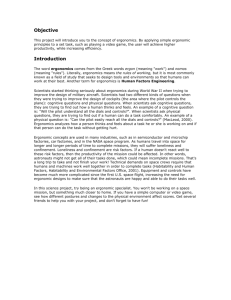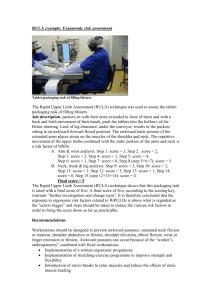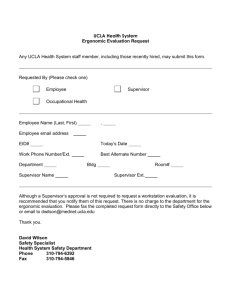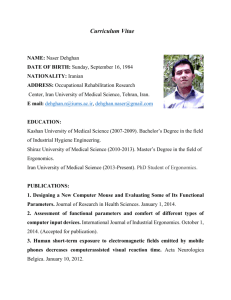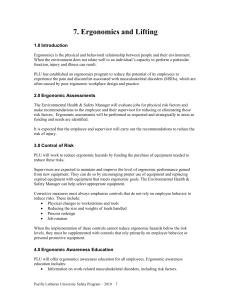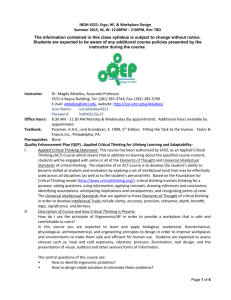Ergonomic self evaluation form for lab work
advertisement
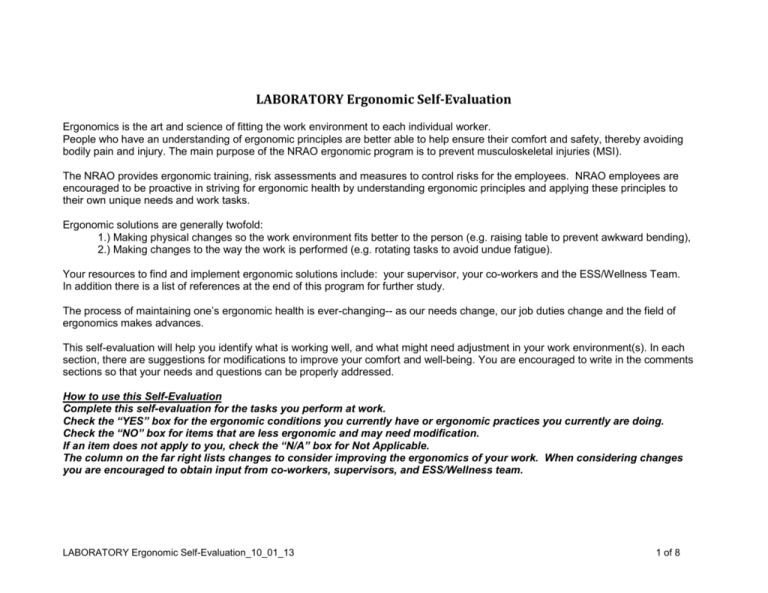
LABORATORY Ergonomic Self-Evaluation Ergonomics is the art and science of fitting the work environment to each individual worker. People who have an understanding of ergonomic principles are better able to help ensure their comfort and safety, thereby avoiding bodily pain and injury. The main purpose of the NRAO ergonomic program is to prevent musculoskeletal injuries (MSI). The NRAO provides ergonomic training, risk assessments and measures to control risks for the employees. NRAO employees are encouraged to be proactive in striving for ergonomic health by understanding ergonomic principles and applying these principles to their own unique needs and work tasks. Ergonomic solutions are generally twofold: 1.) Making physical changes so the work environment fits better to the person (e.g. raising table to prevent awkward bending), 2.) Making changes to the way the work is performed (e.g. rotating tasks to avoid undue fatigue). Your resources to find and implement ergonomic solutions include: your supervisor, your co-workers and the ESS/Wellness Team. In addition there is a list of references at the end of this program for further study. The process of maintaining one’s ergonomic health is ever-changing-- as our needs change, our job duties change and the field of ergonomics makes advances. This self-evaluation will help you identify what is working well, and what might need adjustment in your work environment(s). In each section, there are suggestions for modifications to improve your comfort and well-being. You are encouraged to write in the comments sections so that your needs and questions can be properly addressed. How to use this Self-Evaluation Complete this self-evaluation for the tasks you perform at work. Check the “YES” box for the ergonomic conditions you currently have or ergonomic practices you currently are doing. Check the “NO” box for items that are less ergonomic and may need modification. If an item does not apply to you, check the “N/A” box for Not Applicable. The column on the far right lists changes to consider improving the ergonomics of your work. When considering changes you are encouraged to obtain input from co-workers, supervisors, and ESS/Wellness team. LABORATORY Ergonomic Self-Evaluation_10_01_13 1 of 8 LABORATORY Ergonomic Self-Evaluation Yes No N.A. Possible Ergonomic Solutions STANDING BENCH Adjustable height benches Adjustable chair Temporary standing platforms Scissor Lift Table Adjustable Sit-stand chairs Redesign task/workstation Modify bench surface with clamp on cut out extensions Modify bench surface with clampon extensions Move certain tasks to a seated bench with adjustable chair TIP: While standing in place it is best to alternate between feet on the footrest to reduce stress on your lower back. TIP: If workbench has undersurface cabinet, try opening or removing door and placing foot on lower shelf to reduce back strain. Then alternate feet for your comfort. 1. My standing table surface is typically between the height of my elbows and waist while working with heavy items (e.g. engine part). 2. My standing table surface is approximately at height of my elbows while working with lighter items (e.g. small prototype). 3. My standing table surface is about 2 inches above my elbow height while doing precision work (e.g. connecting fibers). 4. There is at least 4” of knee and foot clearance under the standing table(s) for me. LABORATORY Ergonomic Self-Evaluation_10_01_13 Comments: ___________________ ________________________________ ________________________________ 2 of 8 Yes 5. There is a footrest available (~6” from floor) for longer periods of standing. 6. There are cushioned floor mats in areas where I stand for longer periods. TIP: Floor mats with contrasting colors to the floor reduce the risk of tripping. 7. My primary work tools and supplies are located within arm’s reach from table edge? Avoid contact stress 8. The edge of the table is rounded or padded (to avoid contact stress). LABORATORY Ergonomic Self-Evaluation_10_01_13 No N.A. Possible Ergonomic Solutions Wear well fitting cushioned shoes, insoles, arch supports Install foot rails or footrests Anti-fatigue floor mats with sloped edges Reposition tools and supplies within comfortable distance Provide tool organizers, turntable workstations Wheeled cart for supplies & tools Reconfigure work area into an ‘L’ or ‘U’ shape Add edge rests and protectors to eliminate sharp edges Use gel pads on surface to protect elbows Wear custom padded sleeves under lab coat Comments: _____________________ ________________________________ ________________________________ 3 of 8 Yes No N.A. Possible Ergonomic Solutions SEATED BENCH 9. When sitting for longer periods in the lab, I usually have access to a chair or stool that is adjustable to my size. Good posture In the lab chair(s) I usually sit in: 10. I can sit all the way back in the seat and still have 2 to 3 finger widths between the edge of the seat and my calves. Adjustable chair Different size chair Lumbar pillow Footrest Remove clutter from under table Modify bench surface with extensions to increase knee and foot clearance Design tasks so that I can alternate positions more frequently Redesign task or workstation 11. There are arm rests if I need them. 12. I can remove the rests, or pivot the arm rests to get close enough to the work bench. 13. My feet can either rest flat on the floor or I can use a footrest for support. 14. I can sit close to my work and my knees do not touch anything. Poor posture 15. When using foot controls for longer periods, I can use both my left and right legs without twisting my hips and causing strain. Comments: _____________________ _______________________________ _______________________________ LABORATORY Ergonomic Self-Evaluation_10_01_13 4 of 8 Yes No N.A. Possible Ergonomic Solutions Microscopes Reposition microscope Reposition worker Use microscope adapters (e.g. longer eyepieces) Use video system Use forearm support/pad Better lighting or task lighting Ergonomic tweezers/tools Rotate to various tasks every 4-5 hours NWS (Germany) Excelta (Switzerland) 16. I can view through the microscope eyepiece with neutral neck, shoulder and back postures? (Neck flexion < 25°, shoulders relaxed, back upright and supported by chair? ) 17. When using the microscope my forearms are well supported in order to perform fine manipulations. 18. My precision tools are comfortable to hold. Comments: ____________________ _______________________________ _______________________________ n LABORATORY Ergonomic Self-Evaluation_10_01_13 5 of 8 Yes Miscellaneous 19. Clamps and holders are available to support materials that must be held still for prolonged periods. No N.A. Possible Ergonomic Solutions Provide clamps Provide racks, holders, shelves, or organizers 20. There is adequate and appropropriate storage for supplies in my work area. Rearrange materials and open space for most often used items Clean up clutter Provide storage for supplies Place heavy items on shelves between knees and chest level 21. There are adequate bins and racks for frequently used items. Provide bins, racks and shelves for frequently used items 22. I can use a platform for tasks that require lifting arms above chest level for prolonged periods. Standing platforms or elevated work areas TIP: Avoid working with hands above head more than 4 hours per day. LABORATORY Ergonomic Self-Evaluation_10_01_13 Comments: ____________________ _______________________________ _______________________________ 6 of 8 Yes No N.A. Possible Ergonomic Solutions Practices 23. I have equipment that is functioning properly. 24. I try to vary my positions and tasks throughout the day. TIP: “Water, or its lack (dehydration), can influence cognition. Mild levels of dehydration can produce disruptions in mood and cognitive functioning” www.ncbi.nlm.nih.gov/pmc/art icles/PMC2908954/ Regular exercise helps keeps the body toned. Toned muscles are less likely to become overly stretched and weakened, or fatigued and then injured. LABORATORY Ergonomic Self-Evaluation_10_01_13 Fix equipment: ______________________________ Access to more than one working station Workstation adjustability to allow for changes in posture Organize tasks to use different muscle groups throughout day Take micro-breaks of 30-60 seconds by moving: standing if sitting sitting if standing close eyes & cup hands over eyes stretching deep breathes walking Comments: ___________________ ________________________________ ________________________________ 7 of 8 Primary References downloaded April 2013: 1. UC-Davis “Laboratory Ergonomic Checklist”. http://safetyservices.ucdavis.edu/ps/ebm/le/laboratoryErgonomicsChecklist.doc/view 2. UC-Davis “Ergonomic Laboratory Equipment Listing”. http://safetyservices.ucdavis.edu/ps/ebm/le/labErgonomicEquipment_070609.doc/view 3. “Making It Right” (pdf) by WorkSafeBC (Worker’s Compensation Board, British Columbia, Canada) http://www.worksafebc.com/publications/health_and_safety/by_topic/assets/pdf/Making_it_Right_BK110.pdf LABORATORY Ergonomic Self-Evaluation_10_01_13 8 of 8
